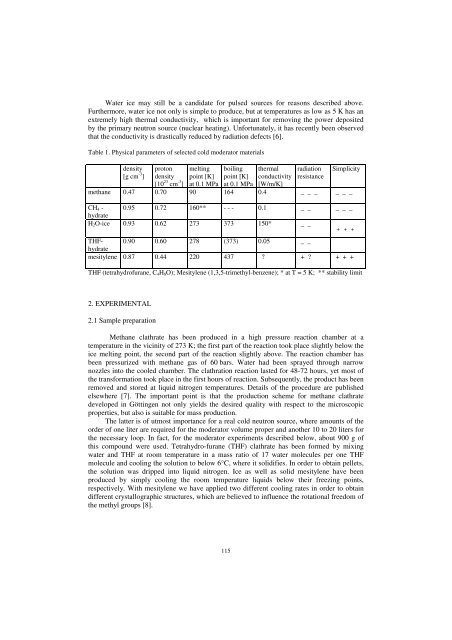Druck-Materie 20b.qxd - JUWEL - Forschungszentrum Jülich
Druck-Materie 20b.qxd - JUWEL - Forschungszentrum Jülich
Druck-Materie 20b.qxd - JUWEL - Forschungszentrum Jülich
Create successful ePaper yourself
Turn your PDF publications into a flip-book with our unique Google optimized e-Paper software.
Water ice may still be a candidate for pulsed sources for reasons described above.<br />
Furthermore, water ice not only is simple to produce, but at temperatures as low as 5 K has an<br />
extremely high thermal conductivity, which is important for removing the power deposited<br />
by the primary neutron source (nuclear heating). Unfortunately, it has recently been observed<br />
that the conductivity is drastically reduced by radiation defects [6].<br />
Table 1. Physical parameters of selected cold moderator materials<br />
methane<br />
CH4 -<br />
hydrate<br />
H2O-ice<br />
THFhydrate<br />
mesitylene<br />
density<br />
[g cm -3 ]<br />
proton<br />
density<br />
[10 23 cm -3 ]<br />
melting<br />
point [K]<br />
at 0.1 MPa<br />
boiling<br />
point [K]<br />
at 0.1 MPa<br />
115<br />
thermal<br />
conductivity<br />
[W/m/K]<br />
radiation<br />
resistance<br />
Simplicity<br />
0.47 0.70 90 164 0.4 _ _ _ _ _ _<br />
0.95 0.72 160** - - - 0.1 _ _ _ _ _<br />
0.93 0.62 273 373 150* _ _<br />
0.90 0.60 278 (373) 0.05 _ _<br />
+ + +<br />
0.87 0.44 220 437 ? + ? + + +<br />
THF (tetrahydrofurane, C4H8O); Mesitylene (1,3,5-trimethyl-benzene); * at T = 5 K; ** stability limit<br />
2. EXPERIMENTAL<br />
2.1 Sample preparation<br />
Methane clathrate has been produced in a high pressure reaction chamber at a<br />
temperature in the vicinity of 273 K; the first part of the reaction took place slightly below the<br />
ice melting point, the second part of the reaction slightly above. The reaction chamber has<br />
been pressurized with methane gas of 60 bars. Water had been sprayed through narrow<br />
nozzles into the cooled chamber. The clathration reaction lasted for 48-72 hours, yet most of<br />
the transformation took place in the first hours of reaction. Subsequently, the product has been<br />
removed and stored at liquid nitrogen temperatures. Details of the procedure are published<br />
elsewhere [7]. The important point is that the production scheme for methane clathrate<br />
developed in Göttingen not only yields the desired quality with respect to the microscopic<br />
properties, but also is suitable for mass production.<br />
The latter is of utmost importance for a real cold neutron source, where amounts of the<br />
order of one liter are required for the moderator volume proper and another 10 to 20 liters for<br />
the necessary loop. In fact, for the moderator experiments described below, about 900 g of<br />
this compound were used. Tetrahydro-furane (THF) clathrate has been formed by mixing<br />
water and THF at room temperature in a mass ratio of 17 water molecules per one THF<br />
molecule and cooling the solution to below 6°C, where it solidifies. In order to obtain pellets,<br />
the solution was dripped into liquid nitrogen. Ice as well as solid mesitylene have been<br />
produced by simply cooling the room temperature liquids below their freezing points,<br />
respectively. With mesitylene we have applied two different cooling rates in order to obtain<br />
different crystallographic structures, which are believed to influence the rotational freedom of<br />
the methyl groups [8].

















